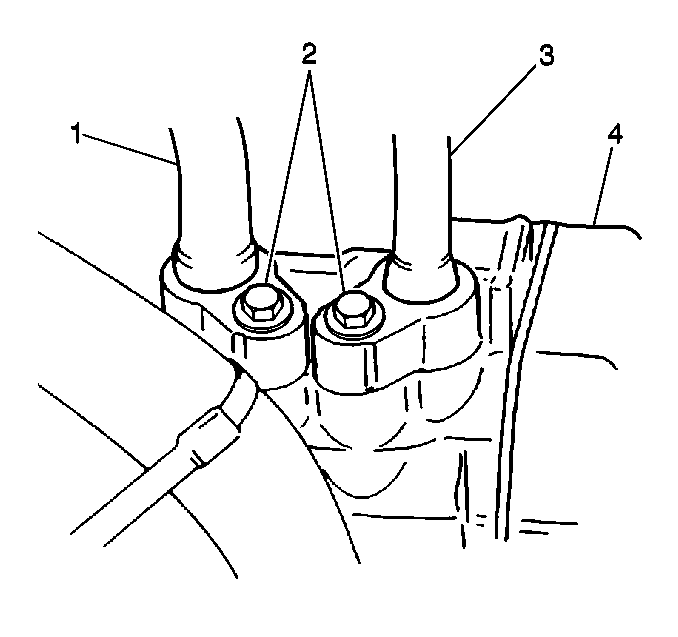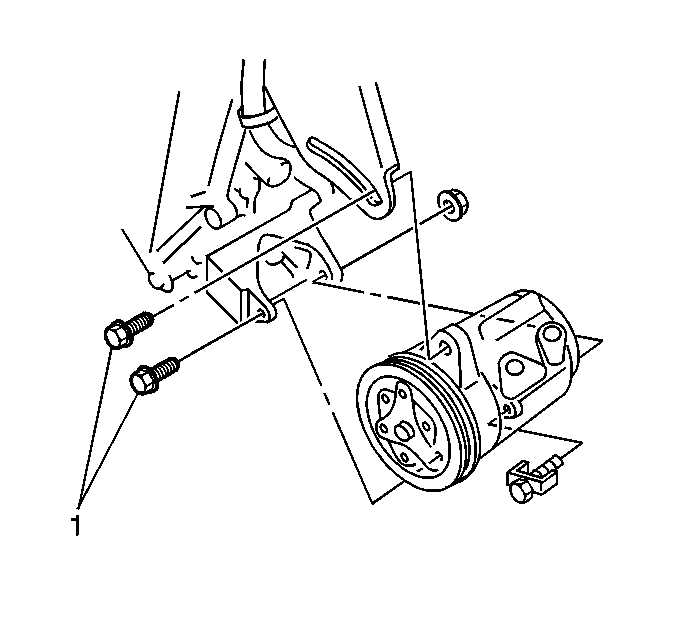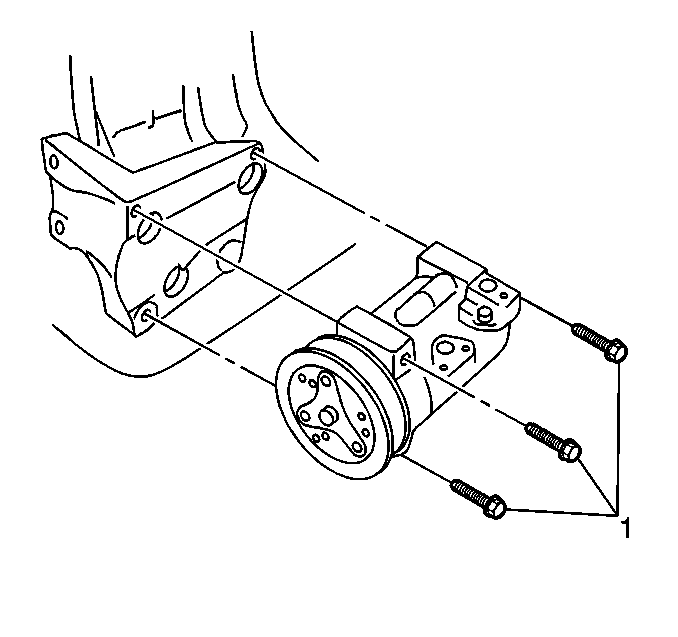Removal Procedure
Important: When replacing the compressor, drain the oil and measure the amount.
Add this amount when installing a new compressor. New compressors are shipped
with 120 ml (4.0 fl oz) of oil. Drain oil from the
new compressor as necessary in order to ensure that the removed amount of
oil and the added amount of oil are equal.
- Discharge and recover the refrigerant. Refer to Refrigerant Recovery and Recharging
.
Caution: Unless directed otherwise, the ignition and start switch must be in the OFF or LOCK position, and all electrical loads must be OFF before servicing
any electrical component. Disconnect the negative battery cable to prevent an electrical spark should a tool or equipment come in contact with an exposed electrical terminal. Failure to follow these precautions may result in personal injury and/or damage to
the vehicle or its components.
- Disconnect
the negative battery cable.

- Remove 1 bolt (2)
and the suction hose (1) from the compressor.
- Remove 1 bolt (2) and the discharge hose (3)
from the compressor.
- Discard the O-rings.
- Cap all of the refrigerant line openings in order to keep out
dirt and moisture.
- Disconnect the compressor clutch electrical connector.

- Perform the following
if the vehicle is equipped with the 1.6L engine:
| 8.1. | Remove the compressor upper mounting bolt (1). |
| 8.2. | Remove the compressor lower mounting bolt. |
| 8.3. | Remove the compressor lower mounting nut and bolt. |
| 8.4. | Remove the compressor from the vehicle, while disengaging the
compressor drive belt from the compressor clutch pulley. |

- Perform the following
if the vehicle is equipped with the 2.0L engine:
| 9.1. | Remove the compressor drive belt from the compressor pulley. Refer
to
Drive Belt Replacement
in Engine Mechanical. |
| 9.2. | Remove the 3 compressor mounting bolts (1). |
| 9.3. | Remove the compressor from the vehicle. |
Installation Procedure

Notice: Use the correct fastener in the correct location. Replacement fasteners
must be the correct part number for that application. Fasteners requiring
replacement or fasteners requiring the use of thread locking compound or sealant
are identified in the service procedure. Do not use paints, lubricants, or
corrosion inhibitors on fasteners or fastener joint surfaces unless specified.
These coatings affect fastener torque and joint clamping force and may damage
the fastener. Use the correct tightening sequence and specifications when
installing fasteners in order to avoid damage to parts and systems.
- Perform the following
if the vehicle is equipped with the 1.6L engine:
| 1.1. | Install the compressor to the vehicle, while engaging the compressor
drive belt to the compressor clutch pulley. |
| 1.2. | Install the compressor upper mounting bolt (1). |
| 1.3. | Install the compressor lower mounting bolt. |
| 1.4. | Install the compressor lower mounting nut and bolt. |
Tighten
Tighten the compressor mounting bolts to 23 N·m (17 lb ft).

- Perform the following
if the vehicle is equipped with the 2.0L engine:
| 2.1. | Install the compressor to the vehicle. Secure the compressor with
the 3 mounting bolts (1). |
Tighten
Tighten the compressor mounting bolts to 23 N·m (17 lb ft).

- Coat new discharge and
suction hose O-rings with mineral base 525 viscosity refrigerant oil.
- Connect the discharge and the suction hoses to the compressor.
Secure with two bolts (2).
Tighten
Tighten the compressor discharge and suction hose bolts to 35 N·m
(26 lb in).
- Connect the compressor clutch electrical connector.
- Connect the negative battery cable.
- Evacuate and recharge the air conditioning system. Refer to Refrigerant Recovery and Recharging
.
- Operate the A/C system and test for refrigerant leaks. Refer to Leak Testing
.






